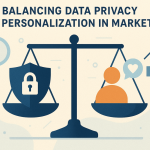In my experience working with realtime trading and regulatory reporting systems, even a few minutes of data pipeline downtime can have outsized costs. One analysis estimates UK financial firms lose on average over 7,000 per minute of system outage, not to mention reputational damage and fines. To meet the FCA/PRA's strict resilience rules and high-frequency reporting demands … [Read more...] about Designing Self-Diagnosing, Self-Healing Data Pipelines for UK Finance
Technical
Learn all about technical data and programming and why it's crucial for businesses. Get knowledge on how to collect and use this information to improve your products and services.
How Technology Shapes Human Timing and Performance in Media
When people watch video, they respond to more than the visuals. A pause, a breath, or the way a phrase is delivered often matters as much as the image itself. These small details influence whether a clip feels natural. Reproducing them has long been difficult in digital production, but new systems are beginning to take on part of that work.Why rhythm matters in viewingAudiences … [Read more...] about How Technology Shapes Human Timing and Performance in Media
Balancing Data Privacy and Personalization in Marketing
Balancing Data Privacy and Personalization in MarketingPersonalization has emerged as a defining characteristic of effective marketing in today's connected world. Consumers expect brands to understand their needs, likes, and activities-even before they say anything about them. But with the expectation of personalization comes an equally powerful expectation of privacy. As … [Read more...] about Balancing Data Privacy and Personalization in Marketing
Network Inventory Data Could Become Telecom’s Biggest Blind Spot…
Seems like a rather bold statement to make, considering it's the backbone of telecom networks. Let's unpack this a little bit more and make the blind spot a bit clearer to understand. As we know, telecom networks are scaling, densifying, and diversifying faster than ever before. Fiber rollouts are accelerating, 5G backhaul is intensifying, and legacy infrastructure is still … [Read more...] about Network Inventory Data Could Become Telecom’s Biggest Blind Spot…
Disconnected Demographic Data? Here’s How Data Appending Can Fix It
B2B marketing strategies suffer from blind spots due to incomplete demographic data. Decision-makers cannot tailor their approaches effectively without vital client demographic information. When B2B enterprise leaders use poor-quality demographic data for marketing, they might waste resources and experience suboptimal campaign results. Data append services bridge these … [Read more...] about Disconnected Demographic Data? Here’s How Data Appending Can Fix It
What is technical data?
Technical data can be something as simple as a list of ingredients for a recipe or a more complex set of instructions for assembling a piece of furniture. Technical data can also be mathematical formulas or set points for calibration. No matter what form it takes, technical data is always designed to provide information that will help people to understand and use a particular product or service.
In some cases, technical data may be subject to special regulations, such as those governing the handling of confidential personal information. However, in general, technical data is considered to be publicly available information. Want to learn more about technical data? Datafloq has courses available. Contact us to get started.
What is the purpose of technical data?
Technical data is often used to create engineering drawings or specifications, which are then used to manufacture the product. Technical data can also be used to troubleshoot problems with a product or system.
For example, if a component is not working properly, technicians may refer to the technical data to determine the root cause of the problem. Technical data is an essential part of the product development process and can be very useful for businesses and consumers.
What are examples of technical data?
Technical data refers to the specifications of a product or system, including its performance, dimensions, weight, etc. It is often used in the context of engineering or manufacturing. For example, engineers will consider the vehicle’s weight, aerodynamics, and engine size when designing a new car.
Technical data can also be used to compare different products or systems. For example, if you are trying to decide between two different types of printers, you might look at their printing speed, paper capacity, and resolution.
What is technical data analysis?
Technical data analysis aims to help make better decisions by understanding the data better. Technical data analysis can be used for different purposes, such as predicting future events, identifying trends, or spotting outliers. Many different statistical methods can be used for technical data analysis, and the choice of method will depend on the type of data and the question you are trying to answer.
What is a high-tech startup?
A high-tech startup is a company that uses technology to create new products or services. These startups are usually founded by entrepreneurs with innovative ideas for a new business. Many high-tech startups are based around developing new software or hardware, but some may also focus on creating new medical devices or developing new clean energy technologies.
Whatever their focus, all high-tech startups share a common goal: to bring their innovative ideas to market and create value for their customers.
What is a high-tech business?
A high-tech business is an organization that develops or uses advanced technological processes and products in its operations. Many high-tech businesses are involved in research, development, engineering, and manufacturing. They often work with cutting-edge technologies, such as artificial intelligence, biotechnology, and nanotechnology.
These businesses typically require a highly skilled workforce and substantial investment in research and development. Due to the risky nature of developing new technologies, many high-tech businesses are venture-backed startups. However, some large companies, such as Google and Apple, are also considered high-tech businesses.






